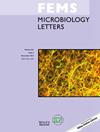牛奶蛋白诱发过敏性肠炎小鼠肠道微生物群变化和过敏性炎症的研究
IF 2.2
4区 生物学
Q3 MICROBIOLOGY
引用次数: 0
摘要
本研究旨在探讨牛奶蛋白引起的过敏性肠炎小鼠肠道微生物群的变化和过敏性炎症。本研究中,乳清蛋白(WP致敏)组雌性BALB/C小鼠灌胃WP和生理盐水,假致敏组每周灌胃一次生理盐水,持续5周。一周后,给对可湿性粉剂过敏的小鼠注射 60 毫克β-乳球蛋白(BLG)。结果表明,可湿性粉剂致敏组小鼠体重下降,粪便稀薄且带血,全身过敏反应和耳肿胀增加。可湿性粉剂致敏组小鼠的可湿性粉剂特异性 Ig、mMCP-1、粪便钙蛋白和炎症相关因子水平均升高。WP致敏组肠道组织受损严重,ZO-1、Claudin-1和Occludin表达量减少。16S rRNA测序结果显示,两组肠道微生物的操作分类单位(OUT)水平存在差异,可湿性粉剂致敏组的梭状芽孢杆菌(o_Clostridiales)、梭状芽孢杆菌(c_Clostridia)和钩端螺旋体(f_Lachnospiraceae)含量更高。总之,可湿性粉剂致敏可诱发小鼠过敏性炎症、肠道损伤和肠屏障功能障碍,同时肠道微生物也发生了变化,这为可湿性粉剂致敏小鼠的治疗提供了参考。本文章由计算机程序翻译,如有差异,请以英文原文为准。
Investigation of gut microbiota changes and allergic inflammation of mice with milk protein-induced allergic enteritis
This study aimed to investigate the changes of gut microbiota and allergic inflammation in mice with allergic enteritis caused by milk protein. In this study, female BALB\C mice in the whey protein (WP-sensitized) group were gavaged with WP and normal saline, the sham-sensitized group was given normal saline once a week for 5 weeks. One week later, the WP-sensitized mice were administered 60 mg β-lactoglobulin (BLG). The results showed that mice's body weight decreased, feces with loose and bloody, and systemic allergic reactions and ear swelling increased in the WP-sensitized group. The levels of WP-specific Ig, mMCP-1, calprotectin of feces, and inflammation-related factors in the WP-sensitized group were increased. WP-sensitized group intestine tissues were damaged severely and the expressions of ZO-1, Claudin-1 and Occludin reduced. The results of 16S rRNA sequencing showed that there were differences in operational taxonomic units (OUT) levels of gut microbes between the two groups, o_Clostridiales, c_Clostridia and f_Lachnospiraceae were more abundant in the WP-sensitized group. In conclusion, the WP sensitization can induce the allergic inflammation, intestinal injury and intestinal barrier dysfunction in mice, and the gut microbes were also changed, which provided a reference for the treatment of WP-sensitized mice.
求助全文
通过发布文献求助,成功后即可免费获取论文全文。
去求助
来源期刊

Fems Microbiology Letters
生物-微生物学
CiteScore
4.30
自引率
0.00%
发文量
112
审稿时长
1.9 months
期刊介绍:
FEMS Microbiology Letters gives priority to concise papers that merit rapid publication by virtue of their originality, general interest and contribution to new developments in microbiology. All aspects of microbiology, including virology, are covered.
2019 Impact Factor: 1.987, Journal Citation Reports (Source Clarivate, 2020)
Ranking: 98/135 (Microbiology)
The journal is divided into eight Sections:
Physiology and Biochemistry (including genetics, molecular biology and ‘omic’ studies)
Food Microbiology (from food production and biotechnology to spoilage and food borne pathogens)
Biotechnology and Synthetic Biology
Pathogens and Pathogenicity (including medical, veterinary, plant and insect pathogens – particularly those relating to food security – with the exception of viruses)
Environmental Microbiology (including ecophysiology, ecogenomics and meta-omic studies)
Virology (viruses infecting any organism, including Bacteria and Archaea)
Taxonomy and Systematics (for publication of novel taxa, taxonomic reclassifications and reviews of a taxonomic nature)
Professional Development (including education, training, CPD, research assessment frameworks, research and publication metrics, best-practice, careers and history of microbiology)
If you are unsure which Section is most appropriate for your manuscript, for example in the case of transdisciplinary studies, we recommend that you contact the Editor-In-Chief by email prior to submission. Our scope includes any type of microorganism - all members of the Bacteria and the Archaea and microbial members of the Eukarya (yeasts, filamentous fungi, microbial algae, protozoa, oomycetes, myxomycetes, etc.) as well as all viruses.
 求助内容:
求助内容: 应助结果提醒方式:
应助结果提醒方式:


